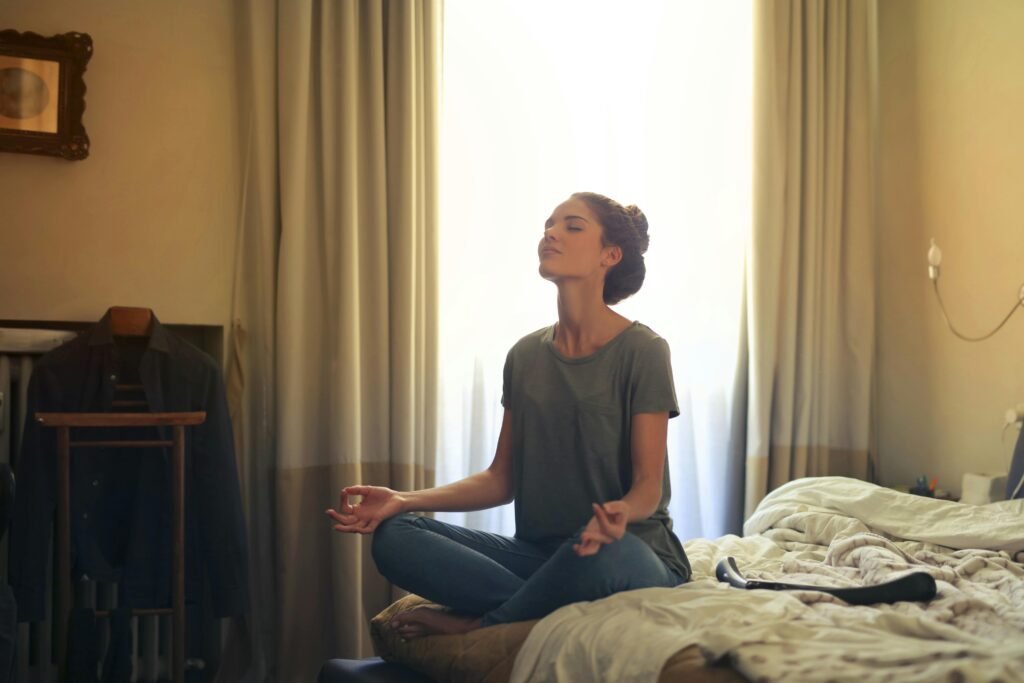
Understanding Overthinking and Anxiety
Overthinking typically involves excessive rumination on events, decisions, or worries, which often exacerbates anxiety.
This mental state can lead to restless nights as unresolved thoughts persistently disrupt sleep.
Recognizing the pattern of overthinking is the first step in addressing it.
Acknowledging that your thoughts may be a result of anxiety and that they do not define reality can be liberating.
It helps to reframe these thoughts and understand they are part of the anxiety cycle.
One of the core issues with overthinking is that it keeps the mind in a heightened state of alertness.
This constant state of vigilance can make it difficult to relax and fall asleep.
The thoughts can range from rehashing past mistakes to worrying about future events, creating a vicious cycle of anxiety and insomnia.
The inability to turn off this mental chatter can be draining, both emotionally and physically.
Understanding that overthinking is often a coping mechanism can also be insightful.
When faced with uncertainty or stress, some individuals overthink as a way to feel more in control.
However, this strategy often backfires, leading to increased anxiety and disrupted sleep.
Overthinking can also be linked to perfectionism, where there is a relentless need to get everything just right, leading to more stress and worry.
It’s also important to note that overthinking can be a symptom of underlying issues such as generalized anxiety disorder (GAD) or other mental health conditions.
Identifying these underlying issues with the help of a mental health professional can be crucial for effective management.
Cognitive Behavioral Therapy (CBT) is often recommended for breaking the cycle of negative thinking patterns associated with anxiety.
Another aspect to consider is the role of negative thought patterns, such as catastrophizing or all-or-nothing thinking.
These patterns can magnify minor issues into significant concerns, further feeding the cycle of anxiety and overthinking.
Learning to identify and challenge these thought patterns can be a powerful tool in reducing their impact.
Overall, understanding overthinking and its connection to anxiety involves recognizing its triggers, patterns, and underlying causes.
This awareness can pave the way for adopting strategies and tools that promote mental clarity and relaxation, ultimately improving sleep quality.
Establish a Relaxing Bedtime Routine

Creating a peaceful and consistent bedtime routine can significantly help in reducing nighttime anxiety.
Start by setting a regular sleep schedule; going to bed and waking up at the same time every day helps regulate your body’s internal clock.
This consistency trains your body to expect rest at a certain time, making it easier to fall asleep.
Incorporate calming activities into your routine.
Reading a book, for example, can be a great way to unwind.
Choose a book that relaxes you rather than something too stimulating or suspenseful.
Another option is to take a warm bath or shower about an hour before bed.
The drop in body temperature afterward can help signal to your brain that it’s time to wind down.
Aromatherapy can also play a beneficial role. Scents like lavender or chamomile are known for their calming properties.
Consider using an essential oil diffuser in your bedroom or adding a few drops of essential oil to your bath.
These scents can help create a soothing environment conducive to sleep.
It’s also helpful to prepare your sleeping environment to be as comfortable and calming as possible.
This might involve investing in good-quality bedding, ensuring your room is cool and dark, and eliminating any noise disturbances.
If outside noise is a problem, a white noise machine or earplugs can be useful tools.
Another element to consider is limiting caffeine and heavy meals in the hours leading up to bedtime.
Both can interfere with your ability to fall asleep and stay asleep. Opt for a light snack if you’re feeling hungry before bed, but avoid anything too rich or spicy.
Additionally, it’s worth setting aside time to decompress from the day’s events.
You might want to spend a few minutes writing in a journal, reflecting on your day, or jotting down any thoughts that come to mind.
This practice can help clear your mind of lingering worries and set a positive tone for the night.
By focusing on these calming activities and creating a consistent routine, you can signal to your brain that it’s time to relax and prepare for sleep.
This preparation helps to reduce overthinking and anxiety, making it easier to achieve a restful night’s sleep.
Practice Mindfulness and Meditation

Mindfulness and meditation are powerful tools for combating anxiety and overthinking.
These practices focus on being present in the moment and can help reduce intrusive thoughts.
Studies have shown that mindfulness meditation significantly improves sleep quality both immediately after the intervention and even months later as they improve sleep quality when compared with other nonspecific controls.
They promote a neutral assessment of your thoughts, which can ease the tension associated with sleep-interfering cognitive processes and facilitate a more restful sleep.
Consider using meditation apps designed to guide you into a peaceful sleep.
The skills learned from mindfulness meditation may result in long-lasting changes in the brain, which can support better sleep by altering sleep-related brain regions.
To practice mindfulness, begin by finding a quiet, comfortable space where you won’t be disturbed.
Sit or lie down in a relaxed position, close your eyes, and take a few deep breaths to center yourself.
Focus your attention on your breathing, noticing the sensation of the air entering and leaving your body.
If your mind begins to wander, gently guide your attention back to your breath without judgment.
Guided meditations can also be helpful, especially if you’re new to the practice.
These meditations often include soothing background music or nature sounds to help you relax.
There are many apps and online resources that offer guided sessions tailored for sleep and anxiety reduction.
Another technique to consider is body scan meditation.
This involves mentally scanning your body from head to toe, paying attention to any areas of tension or discomfort.
As you become aware of these sensations, breathe deeply and imagine the tension melting away with each exhale.
Loving-kindness meditation is another method that can reduce anxiety.
In this practice, you focus on sending positive thoughts and well-wishes to yourself and others.
This can create a sense of peace and emotional connection, counteracting the isolation and stress often associated with overthinking.
Limit Screen Time Before Bed

It’s crucial to be mindful of screen time before bed, as the blue light emitted from phones, tablets, and computers can significantly disrupt your sleep-wake cycle.
This type of light suppresses melatonin production, a hormone essential for regulating sleep.
By reducing screen time at least an hour before you intend to sleep, you can help your body naturally prepare for rest.
Instead of scrolling through social media or watching videos, consider engaging in activities that don’t involve screens.
Reading a physical book or doing some light stretching can be excellent alternatives.
These activities not only help you unwind but also signal to your brain that it’s time to relax and prepare for sleep.
If you must use your phone or computer close to bedtime, consider enabling the device’s night mode or using blue light filters.
These settings reduce the amount of blue light emitted, making it less likely to interfere with melatonin production.
However, it’s still best to minimize screen exposure as much as possible.
Another effective strategy is to create a screen-free zone in your bedroom.
Keeping electronics out of the bedroom can help you associate this space purely with rest and relaxation.
If you use your phone as an alarm clock, consider switching to a traditional alarm clock instead.
Engaging in a calming pre-sleep routine can also help mitigate the impact of screens.
Activities like journaling, as discussed earlier, can help you process your thoughts and clear your mind.
Additionally, incorporating aromatherapy or other relaxation techniques can further signal to your brain that it’s time to wind down.
Lastly, consider setting a nightly routine that allows you to gradually transition away from screen-based activities.
This could involve setting a specific time each night to put away your devices and start your bedtime routine.
Consistency is key in training your body to recognize when it’s time to sleep.
By being mindful of your screen time and incorporating relaxing activities into your nightly routine, you can create an environment that promotes better sleep and reduces nighttime anxiety.
Engage in Physical Activity

Engaging in physical activity can be a highly effective way to manage anxiety and reduce overthinking, particularly in the evenings.
Exercise triggers the release of endorphins, which are natural chemicals in the brain that act as mood elevators.
This can help you feel more relaxed and less anxious, making it easier to transition into a restful night.
Evening workouts don’t have to be intense to be beneficial.
Gentle forms of exercise, such as yoga, walking, or stretching, can be particularly effective.
Yoga, for instance, combines physical movement with deep breathing and mindfulness, making it a holistic approach to relaxation.
Specific yoga poses, like forward bends or restorative postures, can be especially calming and help prepare your body for sleep.
Walking is another excellent option, especially if you can do it in a quiet, natural setting.
A simple walk around your neighborhood or a nearby park can help clear your mind and reduce stress levels.
The rhythmic nature of walking can also be meditative, allowing you to focus on your breathing and the movement of your body rather than on anxious thoughts.
If you prefer a more structured approach, consider following a guided exercise routine.
Many apps and online platforms offer classes specifically designed to help you unwind and relax.
These programs often include a mix of gentle cardio, stretching, and breathing exercises aimed at reducing stress and promoting better sleep.
Another benefit of engaging in physical activity is that it can help regulate your sleep-wake cycle.
Exercise promotes better overall sleep quality by helping you fall asleep faster and enjoy deeper sleep.
However, it’s important to time your workouts appropriately.
While morning or afternoon exercise can be invigorating, engaging in vigorous activity too close to bedtime might have the opposite effect, keeping you more awake.
Therefore, aim to finish any intense workouts at least a couple of hours before you plan to go to bed.
Incorporating physical activity into your daily routine doesn’t require a significant time commitment.
Even 15-30 minutes of gentle exercise can make a noticeable difference in how you feel.
The key is to choose activities that you enjoy and that fit comfortably into your schedule.
Additionally, consistency is crucial.
Making physical activity a regular part of your routine helps to create a sense of predictability and structure, which can be particularly comforting for those struggling with anxiety and overthinking.
By incorporating exercise into your evening routine, you create an opportunity to release built-up tension and shift your focus away from anxious thoughts, paving the way for a more restful and rejuvenating night’s sleep.
Journaling to Process Thoughts

Journaling can serve as an effective way to manage overthinking and anxiety, particularly at night.
By putting your thoughts on paper, you externalize them, making them feel more manageable and less intrusive.
This act of writing allows you to examine your worries more objectively, which can help in reducing their emotional impact.
Consider dedicating a few minutes each evening to jot down your thoughts.
Start by writing about your day: what went well, what challenges you faced, and how you felt.
This simple act of reflection can provide insights into patterns that might be contributing to your anxiety and overthinking.
Another effective technique is gratitude journaling.
Instead of focusing solely on worries or negative thoughts, take time to write down a few things you’re grateful for.
These could be small, everyday moments or significant events.
Shifting your focus to positive aspects of your life can help balance your emotional state and make it easier to let go of anxious thoughts.
If you find it difficult to organize your thoughts, consider using prompts.
Questions like “What is one thing that made me smile today?” or “What’s one challenge I faced, and how did I overcome it?”
can guide your writing and help you explore different aspects of your day and emotions.
Another journaling method to consider is the “brain dump.”
This involves writing down everything that comes to mind without worrying about structure or coherence.
The goal is to clear your mind of clutter, allowing you to approach sleep with a clearer, more focused mindset.
For those dealing with persistent anxiety, consider keeping a worry journal.
In this type of journal, you write down any specific worries or anxieties you have before going to bed.
This can help you acknowledge these thoughts without letting them dominate your mind.
Over time, you may find that many of your worries are less significant than they initially seemed.
Adding a brief reflection at the end of your journaling session can also be beneficial.
Summarize how you feel after writing and note any changes in your mindset.
This practice can help reinforce the positive impact of journaling and make it a more ingrained part of your nightly routine.
Breathing Exercises for Relaxation

Breathing exercises can be an effective way to manage anxiety and overthinking at night.
These exercises work by calming the nervous system and reducing physical tension, making it easier to drift off to sleep.
One well-known technique is the 4-7-8 breathing exercise.
Start by sitting or lying down in a comfortable position.
Close your eyes and take a deep breath in through your nose for a count of four.
Hold your breath for a count of seven. Then, slowly exhale through your mouth for a count of eight.
Repeat this cycle several times.
The rhythmic pattern of breathing can help to quiet your mind and induce a state of relaxation.
Another helpful method is diaphragmatic breathing, also known as belly breathing.
Place one hand on your chest and the other on your abdomen.
Inhale deeply through your nose, ensuring that your diaphragm (not your chest) inflates with enough air to create a stretch in the lungs.
The hand on your abdomen should rise while the hand on your chest remains relatively still.
Exhale slowly through your mouth.
This technique encourages full oxygen exchange, which can slow the heartbeat and lower or stabilize blood pressure.
Progressive muscle relaxation can also complement breathing exercises.
While inhaling, tense a specific muscle group, such as your feet or hands, for a count of five.
Then, exhale and release the tension in that muscle group.
Move progressively through different muscle groups in your body.
This practice can help you become more aware of physical sensations, allowing you to release tension more effectively.
Box breathing, often used by athletes and military personnel, is another technique to consider.
Inhale through your nose for a count of four, hold your breath for a count of four, exhale through your mouth for a count of four, and then hold your breath again for a count of four.
Repeat this cycle multiple times. Box breathing helps balance oxygen and carbon dioxide levels in the body, promoting a sense of calm.
By incorporating these breathing exercises into your nightly routine, you create a structured approach to managing anxiety and overthinking.
The simplicity and effectiveness of these methods make them accessible tools for anyone looking to improve their sleep and overall mental well-being.
